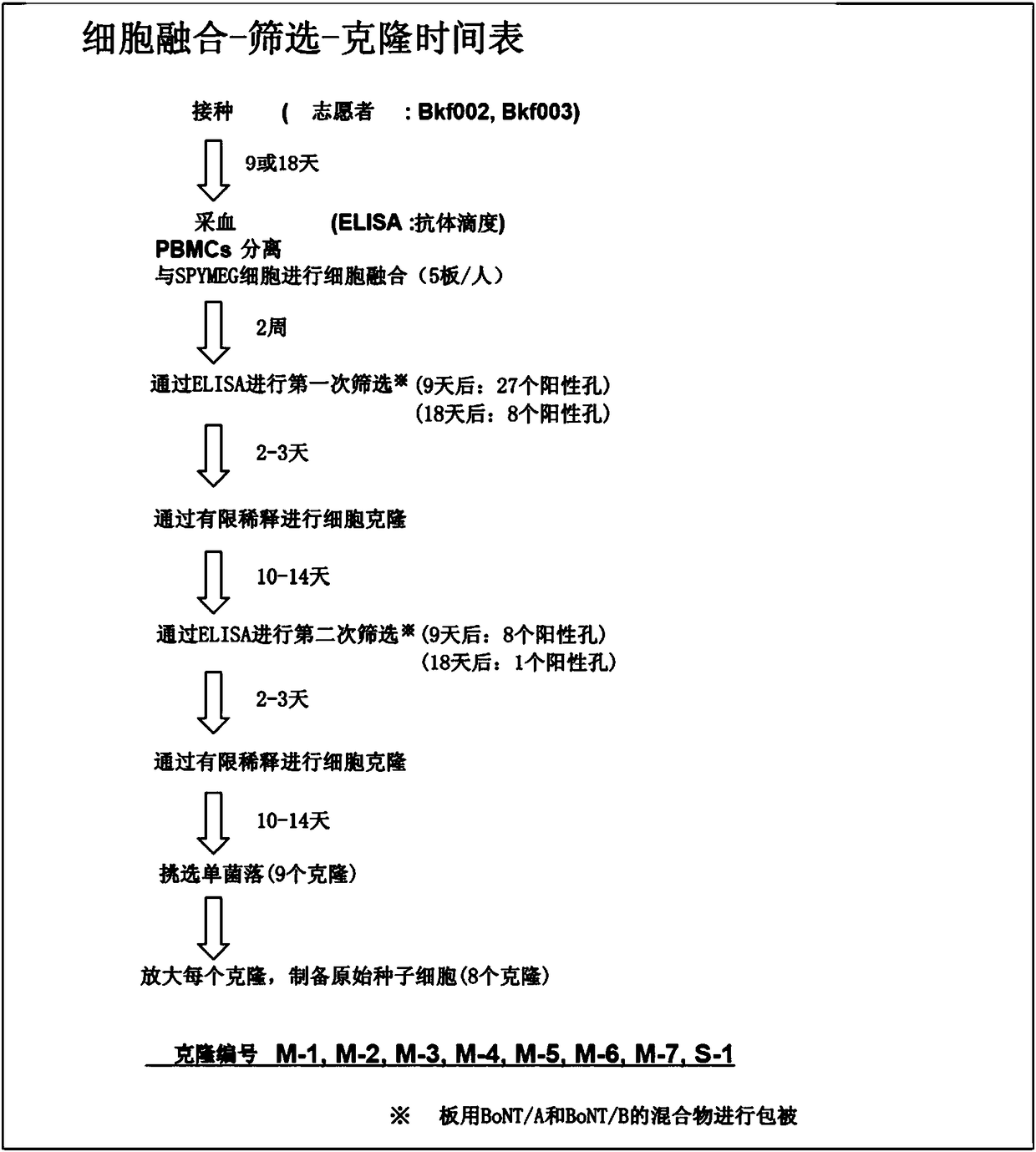Human monoclonal antibody that binds/neutralizes botulinum neurotoxin type b
A technology of human monoclonal antibody and monoclonal antibody, which is applied in the fields of antibodies, antibacterial drugs, nervous system diseases, etc., and can solve the problems of prolonging outpatient rehabilitation treatment and long recovery
- Summary
- Abstract
- Description
- Claims
- Application Information
AI Technical Summary
Problems solved by technology
Method used
Image
Examples
Embodiment 1
[0174] Type B Clostridium botulinum The strain Okra was cultured using the cellophane-tube procedure to obtain a culture supernatant. The precursor toxins (16S toxin and 12S toxin) were purified from the culture supernatant using (Arimitsu et al., Infect. Immun. 71:1599-1603, 2003). BoNT / B1 and NAP-16 were prepared from 16S toxin as described (Arimitsu et al., Infect. Immun. 71:1599-1603, 2003). BoNT / A1 (strain 62A), BoNT / B2 (strain 111) and BoNT / B6 (strain Osaka05) were provided by Dr. S. Kozaki. Quadrivalent botulinum toxoid vaccine was provided by Dr. M. Takahashi. 12S toxin was purified from the respective culture supernatants of Clostridium botulinum types A, B, E, F and detoxified with formalin. Toxin detoxification was detected by intraperitoneal (i.p.) in mice. Four types of toxoid preparations were mixed together and then mixed with aluminum (adjuvant) and thimerosal (preservative). The toxoid preparation contained 0.1 mg of each of the four types, 0.2 mg alumin...
Embodiment 2
[0182] Cell fusion, selection and cloning procedures as described in figure 2 proceed as depicted in . Peripheral blood samples were collected from volunteers 9 or 18 days after the last immunization, and peripheral blood mononuclear cells (PBMC) were purified by Ficoll (GE Healthcare) gradient centrifugation. PBMC and SPYMEG cells were fused at a ratio of 10:1 with polyethylene glycol (Roche). Confluent cells were cultured in 96-well plates in Dulbecco's Modified Eagle's Medium (DMEM, GIBCO) supplemented with 15% FBS in the presence of hypoxanthine-aminopterin-thymidine (HAT, GIBCO) About 10-14 days. After HAT selection, the medium was first screened for antibodies specific for BoNT / A or BoNT / B by ELISA. As a result, 27 positive wells were obtained from blood samples collected 9 days after inoculation, and 8 positive wells were obtained from blood samples collected 18 days after inoculation. Wells positive for specific antibodies are then subjected to cell cloning by lim...
Embodiment 3
[0194] Cloning and sequencing of variable region genes of monoclonal antibodies were performed. The sequences of the determined heavy and light chain variable regions are shown in Figure 3 ~ Figure 8 middle. Total RNA was extracted from hybridomas using the RNeasy Mini Kit (Qiagen) according to the manufacturer's instructions, using SUPERSCRIPT (R) VILO™ cDNA Synthesis Kit (Invitrogen) was generated by RT-PCR. The coding regions of the H- and L-chains of the M-2 and M-4 antibodies were amplified by PCR with KOD-Pus-Neo (Toyobo) and the following primers: 5′-ATGGACTGGACCTGGAGGATCCTC-3′(M-2-H- strand sense primer) (SEQ ID NO: 35), 5′-ATGAAACACCTGTGGTTTCTTCCTCCT-3′ (M-4-H-strand sense primer) (SEQ ID NO: 36), and 5′-CTCCCGCGGCTTTGTCTTGGCATTA-3′ (H-strand antisense primer) (SEQ ID NO: 38); and 5'-ATGGCCTGGWYYCCTCTCYTYCTS-3' (M-4-16-L-strand sense primer) (SEQ ID NO: 38), 5'-ATGSCCTGGGCTCYKCTSCTCCTS-3' (M -2- and M-4-18-L-chain sense primer) (SEQ ID NO: 39), 5'-ATGGCCTGGRYCYCM...
PUM
 Login to View More
Login to View More Abstract
Description
Claims
Application Information
 Login to View More
Login to View More - R&D
- Intellectual Property
- Life Sciences
- Materials
- Tech Scout
- Unparalleled Data Quality
- Higher Quality Content
- 60% Fewer Hallucinations
Browse by: Latest US Patents, China's latest patents, Technical Efficacy Thesaurus, Application Domain, Technology Topic, Popular Technical Reports.
© 2025 PatSnap. All rights reserved.Legal|Privacy policy|Modern Slavery Act Transparency Statement|Sitemap|About US| Contact US: help@patsnap.com



